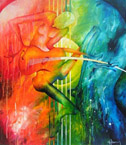Welcome to one of the most active flamenco sites on the Internet. Guests can read most posts but if you want to participate click here to register.
This site is dedicated to the memory of Paco de Lucía, Ron Mitchell, Guy Williams, Linda Elvira, Philip John Lee, Craig Eros, Ben Woods, David Serva and Tom Blackshear who went ahead of us.
We receive 12,200 visitors a month from 200 countries and 1.7 million page impressions a year. To advertise on this site please contact us.
|

|
|
Flamenco time
|
You are logged in as Guest
|
|
Users viewing this topic: none
|
|
Login  | |
|

   
Ricardo
Posts: 14889
Joined: Dec. 14 2004
From: Washington DC

|
 RE: Flamenco time (in reply to Guitarsid) RE: Flamenco time (in reply to Guitarsid)
|
|
|
Slow 3/4 is most common. The quarter note most often defines the tempo, 16th notes subdivisions are the groove. (verdiales, jaleo, slow solea for baile, buleria, etc)
Next most common is 3/4 but faster where dotted half note gets the beat. (fandango, alegria, fast solea, etc).
A very important pattern is alternating quarter note and dotted quarter as the beat. As two dotted quarters followed by 3 quarters where eighth notes keep steady (can occur inside of the the normal slow 3/4 with 16th notes subdivisions as in buleria or guajira and in the faster 3/4 songs like Alegria or quick solea but as alternating dotted half notes or normal half notes and quarters remain steady).
A similar thing (dotted quarter and regular quarters alternate as pulse) where you start from the SECOND quarter, cycle through the pattern and end on the first quarter (siguiriya serrana martinete etc). THis un symmetric pattern is better thought as two odd meters cycling 7/8 and 5/8 grouped as 2+2+3/3+2.
ANother important pattern is the feeling across two bars of 3/4 where the dotted half gets the beat, that there is another slow 3/4 underlaying the two bars. Sort of like 3 half notes trick the ear as the beat...but they are not really, it's an illusion caused by phrasing and or chord changes. (Sevillanas and Fandangos mainly).
The family of 4 beat songs, I strongly feel are better thought of as 2/4 with 16th note subdivisions. As per the feeling and how the foot taps normally. (many many many many people disagree with me and think 4/4 with 8th note subdivisions, but to me it is simpler to think slower tempo 2/4 instead). Goes for rumba, tangos, tientos, taranto por baile, farruca etc etc. Also within this family are the closely related 6/8 songs (tanguillo and zapateado for baile).
Now all that info will help out very adept rhythmic minded folks that studied drumming lets say, but the reality is flamenco has it's own discipline and if you don't learn to count 8th notes and accents like the dancers do (non musicians of course), then you are missing out on some simple tools of communication within the genre. Many of the 3/4 meter songs are counted in cycles of 12, though the un symmetric cylces are counted by the 5 accents. THe 2/4 meter songs are counted in 8.
The SUPER SUPER SUPER important distinction to make with flamenco meter vs other types of music, is that the rhythm cycles don't always lead to the down beat. Sometimes they do but musical phrases inevitably end on the last beat, and often don't start on the down beat. There is a head and a tail to phrases, where as other musics tend to always lead back to the head or downbeat. For example in the slow 3/4 meters, you have many phrases start after 1 and always it ends on or around beat 3 of some other measure. Cuadrao phrases (square phrases) are usually long and end on the 3rd beat of 2nd or 4th measures. "half compas" phrases also end on 3rd beat of odd bars. The same thing manifests in the dotted half 3/4 songs with strong endings on what would be the second measure of the phrase, down beat of or 2nd beat of (as per the illusion that a slower half note is getting the pulse). Often that makes people think of those meters as always 6/4 but we always find again the "half compas" odd 3/4 bar here or there.
And same deal with the 2/4 family, most often beat 2 is the stop ...and again phrases may begin after the 1. In the case of 6/8 tanguillo same deal, stop on 4 of the 6/8 is the same as the stop on 2 of a 2/4.
_____________________________
CD's and transcriptions available here:
www.ricardomarlow.com
|
|
|
|
REPORT THIS POST AS INAPPROPRIATE |
Date Aug. 7 2013 16:34:04
 |
|

   
Guitarsid
Posts: 52
Joined: Aug. 5 2013
From: Maryland USA

|
 RE: Flamenco time (in reply to Morante) RE: Flamenco time (in reply to Morante)
|
|
|
Thanks again, you guys are helping a lot, this forum is a great resource.
btw, I am not really at a stage yet to learn many songs proper, for now I am spending a lot of time just working on the basic techniques like tremelo, rasgueo, etc. and using them in little songs I play "at" like a malaguena, spanish caravan, or with just familiar chord progressions like dm, c, bflat, a, etc.
_____________________________
|
|
|
|
REPORT THIS POST AS INAPPROPRIATE |
Date Aug. 7 2013 17:59:49
 |
|
 New Messages New Messages |
 No New Messages No New Messages |
 Hot Topic w/ New Messages Hot Topic w/ New Messages |
 Hot Topic w/o New Messages Hot Topic w/o New Messages |
 Locked w/ New Messages Locked w/ New Messages |
 Locked w/o New Messages Locked w/o New Messages |
|
 Post New Thread
Post New Thread
 Reply to Message
Reply to Message
 Post New Poll
Post New Poll
 Submit Vote
Submit Vote
 Delete My Own Post
Delete My Own Post
 Delete My Own Thread
Delete My Own Thread
 Rate Posts
Rate Posts
|
|
|
Forum Software powered by ASP Playground Advanced Edition 2.0.5
Copyright © 2000 - 2003 ASPPlayground.NET |
0.046875 secs.
|


 Printable Version
Printable Version









 New Messages
New Messages No New Messages
No New Messages Hot Topic w/ New Messages
Hot Topic w/ New Messages Hot Topic w/o New Messages
Hot Topic w/o New Messages Locked w/ New Messages
Locked w/ New Messages Locked w/o New Messages
Locked w/o New Messages Post New Thread
Post New Thread